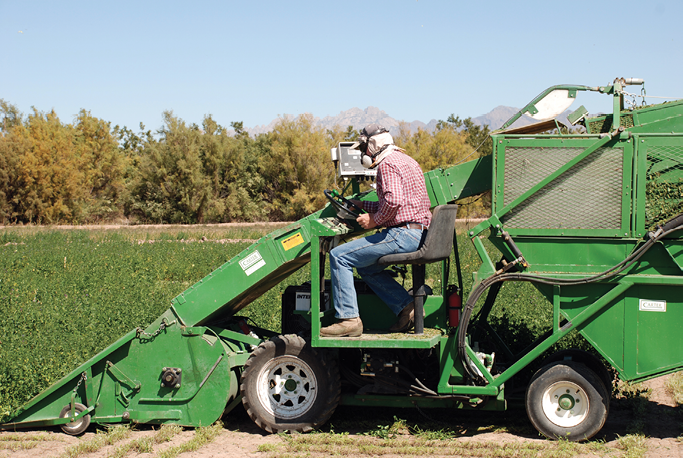Guide Z-120
Dr. Sawssan Boufous and Dr. Madhav Regmi
College of Agricultural, Consumer and Environmental Sciences, New Mexico State University
Authors: Respectively, Extension Specialist/Assistant Professor; Assistant Professor both of Department of Agricultural Economics and Agricultural Business New Mexico State University. (Print-friendly PDF)
Photo courtesy of Jay A. Rodman.
What is a financial feasibility analysis?
A financial feasibility analysis assesses the practicality of the financing terms and performance of a given project plan. In other words, it is an assessment that gives you a clear idea of whether your startup project will generate sufficient and on-time cash flows to cover the cash outflows.
A project is financially feasible when the farm business is profitable, has efficient financial risk management, and has enough continuous liquidity to cover its financial obligations. Financial risks for a ‘new’ project are mainly linked to loan risk.
Then, what is a loan risk?
Loan risk has two components: repayment risk and collateral risk. Collateral risk is the risk of loss from errors in the nature, pricing, or characteristics of collateral. Loan repayment risk refers to the operation’s capacity to generate sufficient cash from sales to repay the loan plus interest according to the contracted financing terms. Failure to repay the loan on schedule puts the borrower into default, and the spillover could adversely impact the lender in the presence of significant collateral risk.
How to manage these risks?
Repayment risk
This ability can be assessed using the pro forma statements and the cash flow budget. A projection of your cash flow budget will allow you to estimate cash coming in and going out based on past performance. This projection also permits one to evaluate the performance of your operation under different economic scenarios using your cash flow budget (that is also your primary tool to initiate a loan repayment analysis) and all information you can gather from the pro forma income statement and balance sheets.
Collateral risk
Numerous influential elements must be considered to evaluate the risk associated with the relationship between the assets you claimed as security for a loan and the outstanding loan balance: seasonality, length of the production process, and your operation’s marketing policies.
The monthly cash flow budget can, then, be the right tool to estimate the seasonality of the operating loan and the cash balances that would be compared with the projected balances of the pledged collateral. This step will allow you to identify when your collateral risk is at its highest point.
What else to consider?
If your project is meant to enter a new market or expand to an existing one, being efficient and financially strong is not enough to guarantee your success. Besides managing risks and having a clear idea of your financial capabilities, exploring your product’s market potential and existing competitors is critical.
This step can be accomplished using many managerial tools, such as the well-known SWOT analysis (S; Strengths; W: Weaknesses; O: Opportunities; T: Threats). Though its apparent simplicity, the accuracy of your SWOT will depend on your ability to spot the most critical external and internal factors that might affect your project based on facts and experience rather than only your own opinions.
A better knowledge of your future/ongoing business environment will allow you to assess whether the allocated capital and expected cash flows will be sufficient to meet all your costs AND the key determinants of business success so that you can proceed with your analysis.
How to do a feasibility assessment?
Gathering all these previous elements should give you a positive/ negative overview of the financial feasibility of your project. Having a strong financial risk management strategy, adequate capital, and a good knowledge of your economic environment can help make better managerial and marketing decisions, resulting in a successful business.
However, several other elements need to be considered based on the nature of your business and the decisions you are/will be making. The first essential one is seasonality. For example, in general, the impact of seasonality on the financial risk is greater for crop producers than livestock producers. This is because crop production is often more sensitive to weather risks than livestock.
Though crop insurance and other risk management practices mitigate these negatives, it is still worth monitoring the seasonality of financial risk and liquidity for all agricultural production units.
Besides seasonality, other important management/marketing decisions can affect the financial feasibility of your project and need to be taken into account:
- Changing the production plans: This includes switching production systems, adopting a new practice, deciding to decrease labor, etc. Any change in your production will likely affect your productivity, expenses, and expected benefits.
- Changing the marketing plans: Such as holding less inventory, changing your crop insurance, or deciding to decrease your price.
- Improving cost control: Monitoring fuel consumption, investing in more efficient new equipment, opting for leasing instead of purchasing new items, and postponing important household expenses.
- Refinancing: Refining an existing debt to secure lower monthly payments or change your loan terms.
- Seeking off-farm income: Deciding to secure additional employment outside your operation.
In sum, conducting a financial feasibility analysis for a future project necessitates not only good-standing finances but also a well-defined risk management strategy and knowledge of the business environment with an emphasis on the nature of your activity and the financial and economic decisions you are making besides your investment.
Example: Suppose you want to purchase a combine harvester that costs $120,000. Assume that:
- You want to use the harvester for 1000 acres of corn at the rate of $30 per acre with an annual increase of 10 percent.
- Operating cash expenses (including repair, fuel, labor, insurance, and housing) cost $16 per acre, with an annual increase of 7 percent annually.
- The combine depreciates at a flat rate of 20% from the first year through year five, and the after-tax salvage value is $40,000.
- The operator is at a 25% tax bracket and finance the custom combine with a 10% down payment at 13% (assume discount rate as the same).
Following the recommendations cited above and the information given, is this project financially feasible?
|
Table 1. An Example of Financial Feasibility Analysis |
|||
|
Year |
Net Cash Flow1 |
After-tax Payment Schedule2 |
Surplus or Deficit +,- |
|
1 |
$15,000 |
$16,393 |
-$1,393 |
|
2 |
$16,410 |
$16,584 |
-$174 |
|
3 |
$17,986 |
$16,799 |
$1,187 |
|
4 |
$19,747 |
$17,042 |
$2,705 |
|
5 |
$21,713 |
$17,317 |
$4,395 |
|
6 |
$19,406 |
$17,628 |
$1,778 |
|
7 |
$21,851 |
$17,979 |
$3,872 |
|
8 |
$24,577 |
$18,376 |
$6,201 |
|
9 |
$27,613 |
$18,824 |
$8,788 |
|
10 |
$70,992 |
$19,331 |
$51,661 |
Table 1 summarizes calculations of elements necessary for our analysis (please refer to the footnote for more details on the calculations).
1Net cash flow calculation includes the cash income, cash expenses, taxes and salvage value (for the final year). Specifically, cash income in the first year is 1000*23 and increases at the rate of 10% afterward. Cash expenses in first year is 16*1000 and grows at 7% rate annually. Taxes include 25% of the basis for each year- generated using cash income, cash expenses, and assumed depreciation.
2After-tax payment schedule comes from loan amortization schedule considering the provided financial terms and tax saving from interest deductibility.
In this example, the Net Present Value (NPV) is $446, which is calculated as the difference between the present value of cash inflows ($120,446) and the present value of cash outflows ($120,000) over ten years, considering a discount rate of 13%. Though NPV is positive, meaning the investment is economically profitable, it doesn’t generate enough cash to make the loan payments during the first two years. Specifically, the business would incur cash deficits of -$1,393 ($16,393 - $15,000) in the first year and -$174 ($16,584 - $16,410) in the second year, suggesting that the business is financially not feasible in the beginning years. In this context, the manager could consider alternative approaches to maintain the liquidity position. Strategies such as extending term contracts and bringing money from other sources to subsidize the harvester purchase with cash could be considered to offset the cash deficits.
Resources
Peter Barry, Paul Ellinger; Financial Management in Agriculture, 7th Edition, Pearson, ISBNs: 9780813427904-013503759X

Sawssan Boufous is an Extension Specialist and Assistant Professor in the Extension Economics Department at the College of Agricultural, Consumer and Environmental Sciences. Her research focuses on sustainability, producer profitability, and the adoption of sustainable agricultural practices, including consumer demand and behavioral economics. She holds multiple advanced degrees in Agricultural and Applied Economics and Management Sciences.

Madhav Regmi studies topics in applied economics, with a particular focus on agribusiness finance, risk management, production economics, and public policy. His research priority is in developing appropriate strategies and public policies to ensure unintended financial consequences from production, marketing, and policy risks for agricultural lenders, agricultural cooperatives, agribusiness firms, and farm households are minimized.
To find more resources for your business, home, or family, visit the College of Agricultural, Consumer and Environmental Sciences on the World Wide Web at pubs.nmsu.edu.
Contents of publications may be freely reproduced, with an appropriate citation, for educational purposes. All other rights reserved. For permission to use publications for other purposes, contact pubs@nmsu.edu or the authors listed on the publication. New Mexico State University is an equal opportunity/affirmative action employer and educator. NMSU and the U.S. Department of Agriculture cooperating.
August 2024. Las Cruces, NM.




